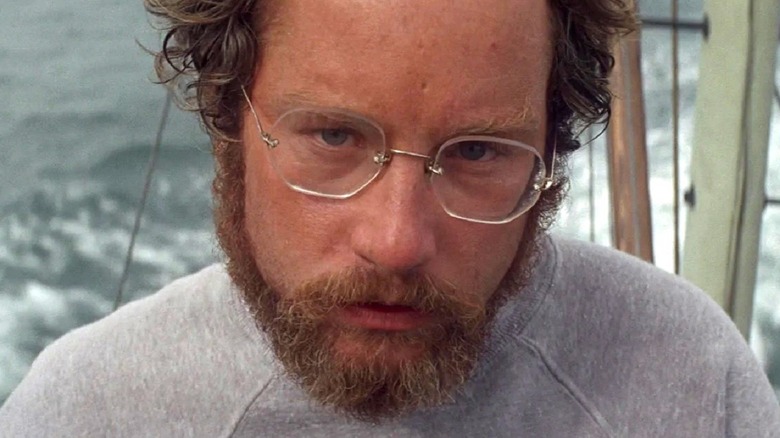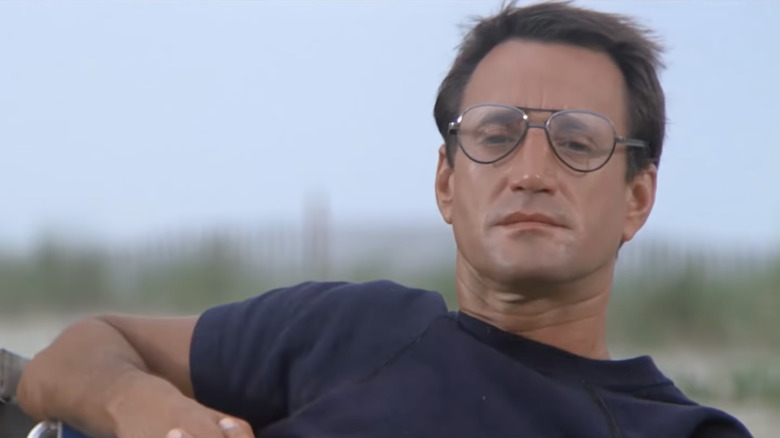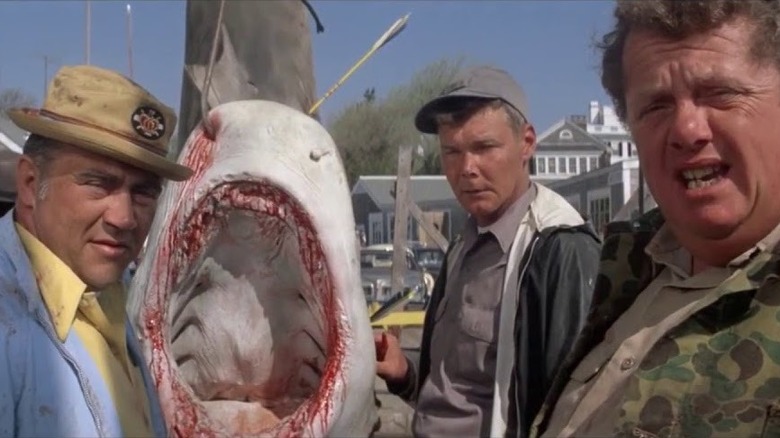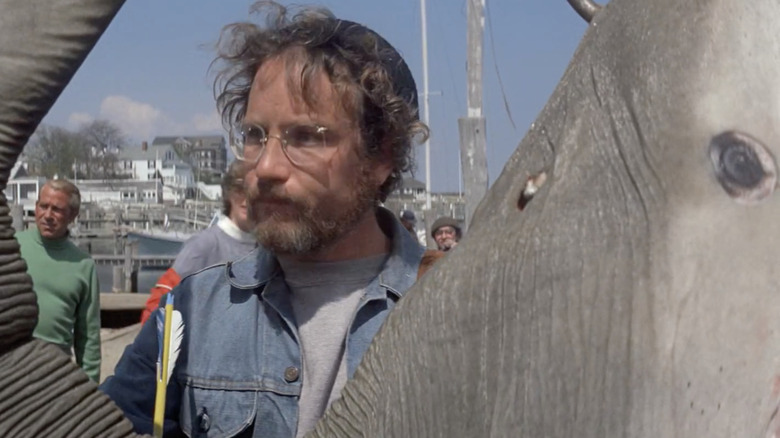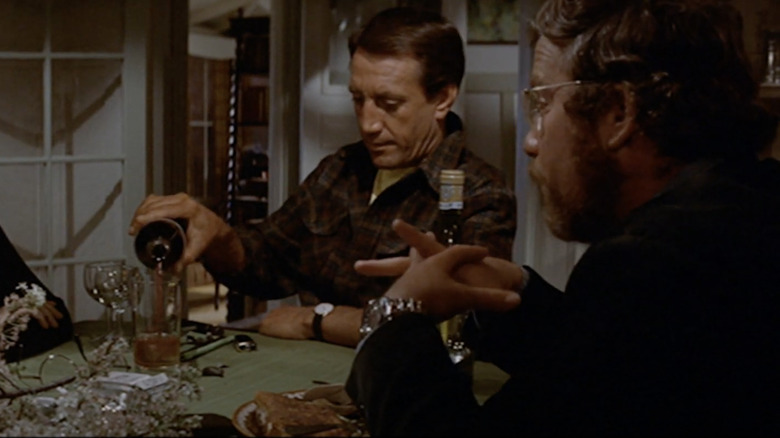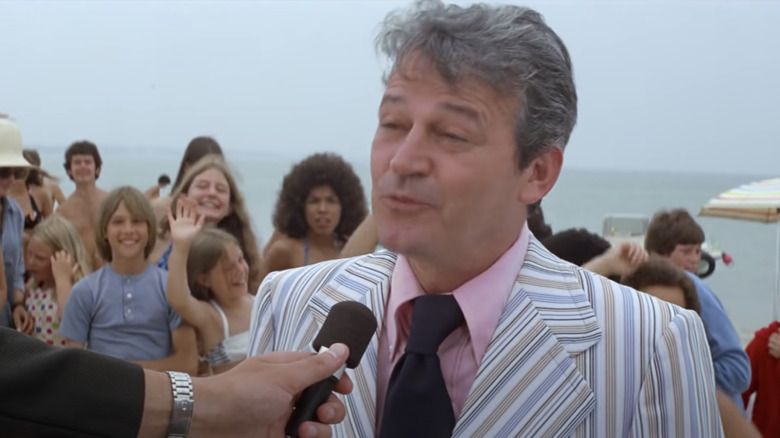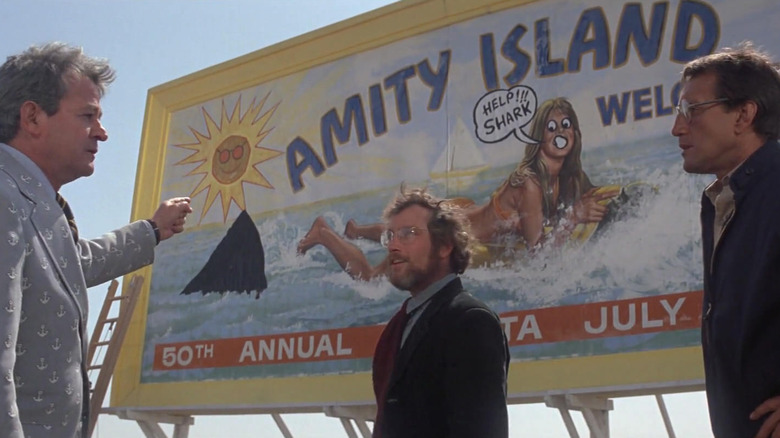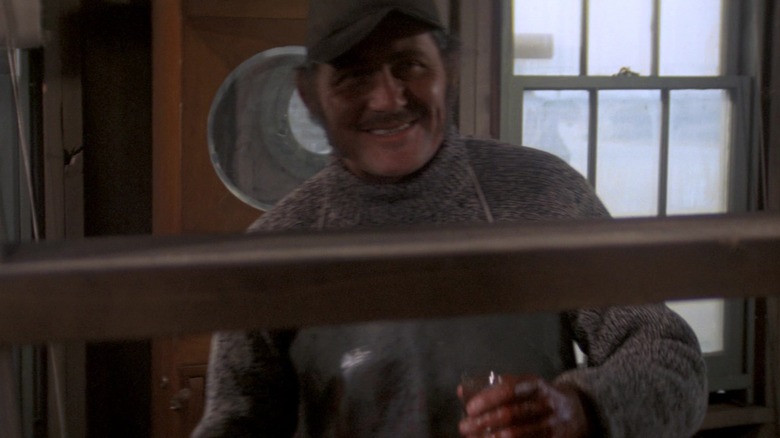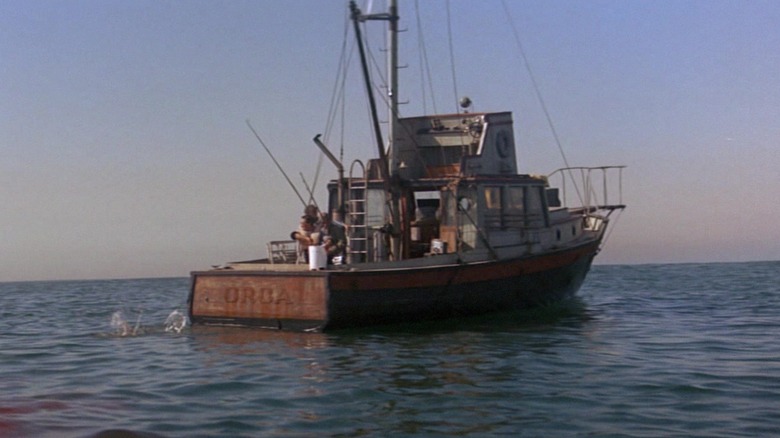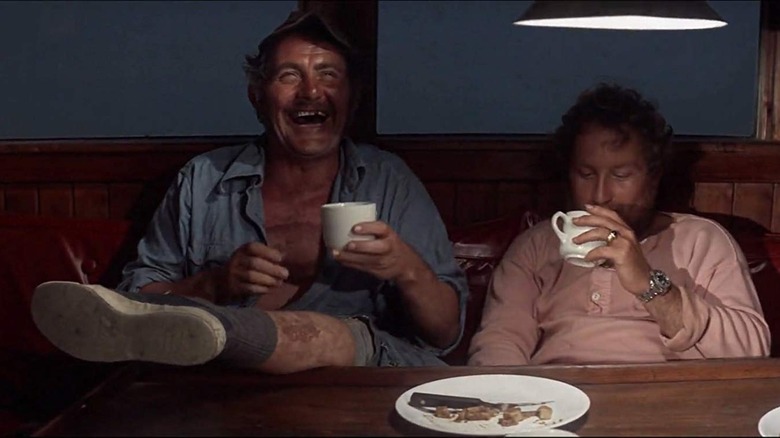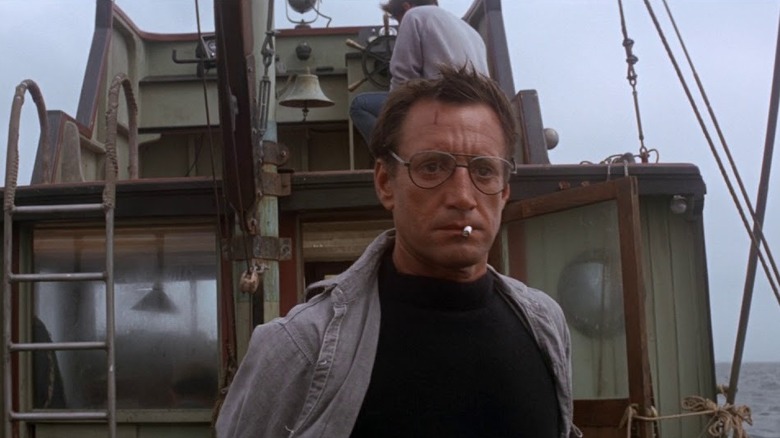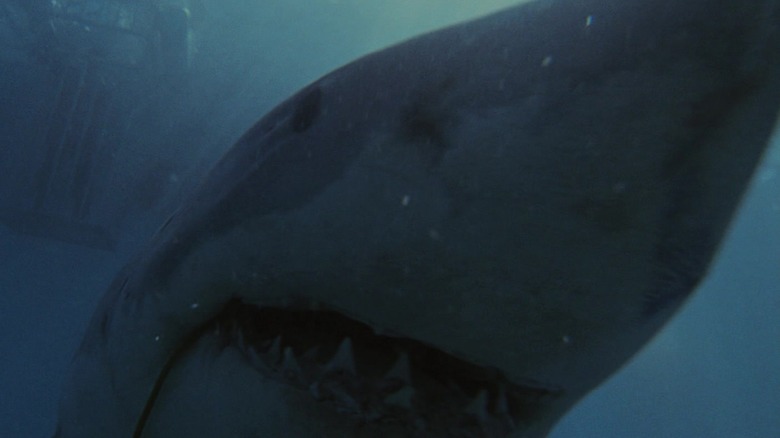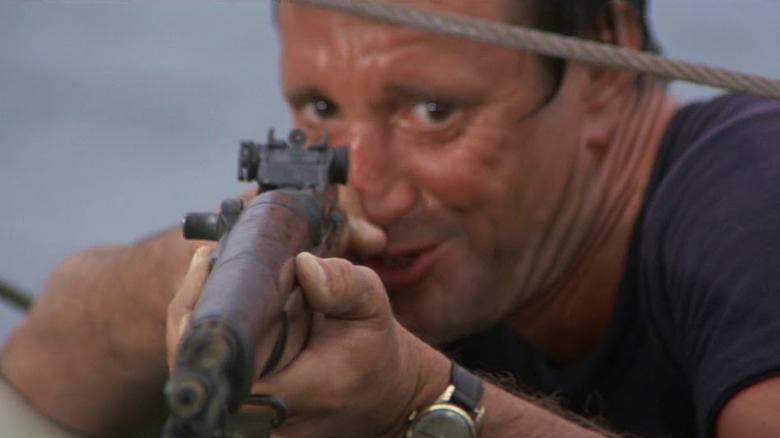Small Details You May Have Missed In Jaws
When it comes to classic movies that changed the cinematic landscape and still hold up today, they don't get any better than "Jaws."
Living up to all the hype, Steven Spielberg's action-horror flick defined the crowd-pleasing "blockbuster" style of marketing and filmmaking that we now take for granted. It also began the slow decline of the New Hollywood period of niche, experimental films — which is ironic since it's very much a part of that movement with its loose, easygoing plot, overlapping dialogue, and film-nerd references.
But unlike so many milestone movies, "Jaws" hasn't gotten one bit less thrilling, despite all the other films that have tried to top it. It's held up to half a century of viewings and re-viewings, but no matter how many times you see it, there's always something new to discover. Here are just a few things to look out for next time you return to Amity Island.
The invisible edits
Director Steven Spielberg made his reputation early not just for delivering meat-and-potatoes thrills but for producing some of the most technically sophisticated filmmaking to ever come out of Hollywood. You can see it all the way from his work on the first episode of "Columbo," where his joy at doing everything he possibly can with a crane shot is downright infectious, to the camerawork in "West Side Story" that seems to dance right along with the characters.
But what makes this entertaining instead of just insufferably show-offy? Well, for one thing, Spielberg's camera tricks are never there just for their own sake — they always serve the story and characters. For another, they have a way of sneaking up on you. It's hard to hard to call Spielberg a show-off when his technique is so unshowy you might miss it.
Take for instance the scene of Roy Scheider as Sheriff Richard Brody nervously watching the beach after trying and failing to get the mayor to shut it down after the first shark attack. It's a simple scene, just Brody's face and the bathers walking by in the foreground. But if you look closer, you'll find something much more complex. With the help of editor Verna Fields, Spielberg ratchets up the tension by pushing Brody closer and closer to us. But instead of showing off this bit of visual storytelling, he disguises it. Every time the camera cuts closer to Brody, it's obscured by a passing beachgoer, making the cuts almost invisible. Even in his 20s, Spielberg already knew one of the secrets of filmmaking: True mastery speaks for itself.
Some weirdo shot arrows into the tiger shark
The news of a killer shark spreads across Amity Island and beyond, and soon, all kinds of rowdy wannabe shark hunters show up, along with the more professional presence of Richard Dreyfuss as oceanographer Matt Hooper. One hunting party is apparently successful when they haul a dead tiger shark onto the docks. Hooper is skeptical — the animal's jaws are too small to match the injuries on its supposed victims. That night, he confirms his suspicions by cutting the shark open and finding nothing but fish and an out-of-state license plate.
In other words, the tiger shark is the center of a lot of plot developments, but you shouldn't let that distract you from the zany details Steven Spielberg and crew added to the scene. The shark hunters seem unfamiliar with the concept of "overkill" since, for some reason, there are two arrows sticking out of the thing's back. Who goes bow hunting on the open ocean? Did some prankster stick it in there after the fact? "Jaws" has more plot-relevant questions to answer, but it's still fun to speculate on this odd bit of background detail.
What's up with the fake-looking tiger shark?
"Jaws" has returned to theaters in both IMAX and 3D formats. These upgrades make the movie more thrilling than ever — but they also reveal some seams that were easier to ignore before. Everyone knows the main shark looks fake. But the malfunctioning animatronic isn't the only weird-looking fish. We're talking about the tiger shark that's killed by some overeager fishermen. If you pay close attention to the animal, there are multiple moments where it looks off — too rubbery, too fake. So is this just another imposter?
Not exactly, but you're not wrong in thinking the shark looks weird. Believe it or not, that's a real tiger shark. "The Jaws Log" records how, with the art department busy with the main shark, the crew scrambled to get a real one to hang up on the dock. Universal's head of casting got ahold of some professional fishermen down in Florida who delivered a 13-footer. But then they started haggling on price, and even when the producers had that settled, there was still the matter of lugging the corpse to New England. Once they got it there, the shark started rotting fast. By the end of the four-day shoot, the makeup department had to touch it up heavily to keep it presentable — until the real shark looked faker than the fake shark.
Brody's strong and nasty cocktail
Sheriff Brody finally gets a sympathetic ear when Hooper appears on the island. After the mayor decides the dead tiger shark is all the proof he needs to reopen the beach, Hooper shows up at the Brody home to commiserate with a bottle of wine, but he's mainly there to talk Brody into helping him get the dead shark out of the evidence locker so they can prove it's not the killer fish.
But the wine comes a little late — when Hooper arrives, Brody's already drowned his sorrows in most of a glass of whiskey. While the motormouthed Hooper keeps talking, Brody silently takes the wine bottle and pours it over what's left of his liquor, completely filling his glass before doling out more reasonable portions for Hooper and his wife, Ellen (Lorraine Gary). Brody somehow manages to choke down this nasty makeshift cocktail, and that tells Hooper all he needs to know. The sarcastic way he asks "how was your day?" shows he obviously already knows the answer.
The mayor refuses to admit the shark killed anyone
Murray Hamilton as Mayor Larry Vaughn is the ultimate pushy politician and heartless capitalist all rolled up into one, stonewalling all of Brody's attempts to do his job and protect his neighbors from underwater dismemberment. He never comes out and says it, but the mayor seems to believe deep down that a few dead swimmers are a small price to pay for tourist dollars.
When a news crew shows up to cover Amity Island's big day on the 4th of July, the mayor shows just how badly skewed his priorities are and how much he's willing to delude himself and the public to maintain them. Listen carefully to what he tells the reporters, as he says, "I'm pleased and happy to repeat the news that we have, in fact, caught and killed a large predator that supposedly injured some bathers."
Technically, being bitten in half counts as an injury, but Vaughn's careful not to admit anyone actually died. He can't even say that much outright — the most he'll admit is the shark was "supposedly" responsible. And then he immediately changes the subject to blather his usual tourist spiel and accidentally cop to the fatal error that will cost a man his life later that day. "But, as you see, it's a beautiful day, the beaches are open, and people are having a wonderful time. Amity, as you know, means 'friendship'"
The mayor actively feeds tourists to the sharks
The great white might be the central villain of "Jaws," but no one in the movie is quite as hateable as the all-too-human Mayor Vaughn. When the general public catches on to the threat that he continues denying, Vaughn's more concerned that some kids painted a shark on a billboard than the fact that a flesh-and-blood shark has killed a teenaged girl and a little boy.
But his most loathsome moment might not sink in at first glance. When the beach fills with tourists for the 4th of July, he's all but directly responsible for the carnage that follows. Seeing the beaches crowded but the ocean empty, he personally goes to the sunbathers one at a time, begging them to go in the water to convince the others it's safe. Or, in other words, he's feeding them to the shark. Because that's exactly how the fish takes it, surfacing in the lagoon to take a big bite of a rowboater and nearly making Brody's son dessert.
Even the mayor realizes how badly he's messed up at this point. When Brody finally gets him to approve his expedition with Quint to find the monster, Vaughn's a nervous wreck. No more bluster and used-car-salesman smiles — he seems like he can no longer raise his voice any higher than a nervous mutter. The danger of the shark has finally become personal to him. He tells Brody, "My kids were on that beach too," just before he gives him the go-ahead.
Brody catches Quint in the middle of gutting a fish
Hooper and the Brodys are all outsiders in Amity, a community that maintains its idyllic image by ruthlessly excluding everyone from the mainland. One neighbor cheerfully tells Brody's wife, "You're not born here, you're not an islander, that's it."
Quint may or may not fit that definition of "islander" — Robert Shaw's thick British accent suggests he doesn't — but no matter what, he's an outsider in his own way. He represents a different side of Amity, far from the clean-cut middle-class characters who seem to dominate the island. Instead, he's what Hooper calls a "working-class hero," a remnant of a time when New England's economy was based on the dirty work of fishing instead of selling a sanitized version of itself to tourists. He says as much in his introduction. "Y'all know me. Know how I earn a livin'," he says, as if he's pre-empting their judgmental attitude. He pointedly continues that the islanders need him to kill the shark. "That'll bring back your tourists, put all your businesses on a payin' basis" — with the emphasis on "your," not "our."
But there's an even more vivid image of Quint's hardscrabble lifestyle when Hooper and Quint recruit him to hunt down the shark. The fisherman shows he's not afraid of getting his hands dirty, and we mean that literally. He's apparently in the middle of gutting a fish when the other two-thirds of his crew show up, and he doesn't even bother to wipe the blood off his hands and apron before handing Brody a drink.
Quint named his boat after a shark killer
Most of the second half of "Jaws" takes place onboard Quint's rickety boat, the Orca. That name isn't the kind of thing that would strike you as important at first — it barely even comes up in the dialogue. But the name was chosen very deliberately.
"Orca" is another name for the mammals commonly called killer whales. For many years, the public image of orcas was defined by their family-friendly antics at SeaWorld (until the documentary "Blackfish" revealed what went on behind the scenes was anything but fun). However, marine biologist Richard Ellis described the orca as "the sea's supreme predator" in his guide to "Dolphins and Porpoises." They don't discriminate in their choice of prey. Ellis lists everything from squids to seals, from small fish to whales to dolphins to ducks — and, yes, sharks.
In fact, Wildlife Online confirms that orcas are one of the few natural predators that full-grown sharks have to worry about. So the name of the Orca ends up landing someone between prophetic and hubristic. It does eventually help kill the shark, but only after the big fish destroys both it and its captain.
Quint and Hooper share a reason for their fascination with sharks
Quint and Hooper are at each other's throats as soon as they meet, with the fisherman dismissing the scientist as a "city boy" and his fancy tools as useless. But if you're paying attention, you may notice that they're both fascinated with sharks for the same reason — trauma.
If you're enough of a "Jaws" fan to get this far, you probably don't need us to summarize Quint's legendary USS Indianapolis monologue. But just in case, the most relevant part is that he watched his entire crew get eaten alive by sharks and spent days wondering if he'd be next. And yet he jumps at the opportunity to hunt down the shark, and that isn't even the first or 50th shark he's killed: His cabin is packed full of shark-tooth trophies.
It might be easier to miss, but Hooper has a similar backstory. When he visits the Brodys for dinner, he explains why he decided to study sharks, and it's the kind of experience that would keep most people far away from them. As a child, he'd hooked a baby shark on a fishing trip. Then he saw firsthand how vicious even the smallest sharks can be when, in his words, "[It] proceeded to eat my boat. ... he turned an inboard into an outboard, scared me to death, and I swam back to shore." Both men process their potentially traumatic experiences in different ways — Quint by killing sharks and Hooper by trying to understand them. But their fundamental motivation remains the same.
Brody wants to make sure everyone heard him
There's one detail in "Jaws" that would be impossible to miss. That's Brody's iconic line when he sees the massive great white up close (too close for comfort) for the first time: "We're gonna need a bigger boat." It's been quoted and parodied more times than we could ever hope to cover here. But you may have missed how often it's quoted and parodied in the movie itself.
Brody's been dealing with his inadequacy compared to his two badass crewmates for the whole voyage, so he knows that when he has a killer one-liner, he's going to milk it for all it's worth. When Quint and Hooper come aft to see what's going on, he says it again in case they missed it the first time: "We're gonna need a bigger boat, right?" Or maybe it's just the opposite, and Brody's so nervous he doesn't even notice he's repeating himself. But by the third time he says the line, even the editor's getting sick of it, and she cuts him off mid-sentence.
Not all the shark shots are fake
If there's one thing in "Jaws" that hasn't aged well, it's Bruce the animatronic shark. Fortunately, the beastie gets a couple of moments where he looks a lot more realistic — mainly because he's played by a real shark. Professional nature documentarians Ron and Valerie Taylor pitched in with some live shark footage, and we get our best look at their work in the scene where Hooper goes underwater in a cage to try and poison the killer shark with a drugged needle.
One of those shots worked so well it saved Hooper's life. In Peter Benchley's original novel, the shark tears both Hooper and his cage apart. Joseph McBride's "Steven Spielberg: A Biography" reveals that one of the Taylors' shots was so good that Spielberg restructured the movie to fit it in. The book quotes producer William S. Gilmore's story of a phone call from Ron Taylor: "He [told] us he had just shot the best footage of his professional life. I said, 'Ron, that's great. Was the little guy in the cage?' He said no. My heart sank. 'Then it's unusable.'"
Spielberg disagreed, and the footage appeared in the final cut, with Hooper's reappearance at the end explaining he wasn't in the ruined cage because he escaped. The director even said, "The shark down in Australia rewrote the script and saved Dreyfuss' character."
Brody's book foreshadows how he'll kill the shark
Everybody remembers the movie's thrilling climax, where, seemingly the last survivor of the Orca, Brody finally gives the shark a dramatic sendoff. After throwing a pressurized air canister into the fish's mouth, Brody tries over and over again to hit it with his rifle. Finally, he gets a bead on it, delivers a classic one-liner ("Smile, you son of a–"), and before he can endanger the movie's PG rating, a spectacular explosion cuts him off.
The scene is shocking — but, if you've been paying attention, not surprising. After the first shark attack, Brody (and pretty much nobody else) gets serious about learning just what he's dealing with. We see him with a stack of books on sharks and get a peek at the illustrations inside — including one gruesome shot that gets Mrs. Brody to do a 180 after dismissing her husband as paranoid and join him in yelling for their kids to get out of the water. There's another one that seems to have made at least as big of an impression on Brody himself. It shows a shark chomping on an air tank, and once you know how he finally dispatches the monster, it's easy to see where he got the idea on how to pull it off.
